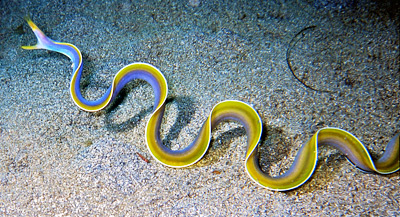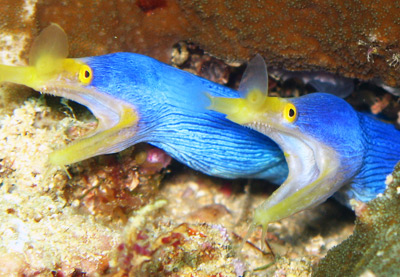Why are the most attractive and interesting-looking marine fish always the most difficult to keep alive in aquariums? Okay, maybe this isn’t actually such a truism. After all, there are lots of gorgeous-yet-easy-to-keep fish in the aquarium trade. It just seems like it’s true when you consider the relative difficulty of keeping certain particularly beguiling species, such as the Moorish idol, green mandarinfish, and the subject of today’s profile—the ribbon eel (Rhinomuraena quaesita).
Physical traits
As its common name implies, R. quaesita has a long, slender, ribbon-like body, reaching approximately 4 feet in maximum length. Three fleshy filaments extend from the tip of the lower jaw, and a single filament is present on the snout. The ribbon eel’s nostrils are greatly enlarged, forming pronounced fanlike structures, which look rather like a set of rabbit ears.
R. quaesita, a protandrous hermaphrodite (males transition into females), goes through dramatic color changes as its gender transforms. Juveniles are black with a yellow dorsal fin. In males, the black coloration changes to blue with yellow on the lower jaw, snout, and dorsal fin. Females are bluish-/greenish-yellow to solid yellow. It was once thought that ribbon eels of each color phase actually represented different species altogether.
Three strikes!
Despite this Indo-Pacific species’ stunning looks, it has several strikes against it: R. quaesita 1) very often refuses to feed in captivity, 2) succumbs to the stresses of capture and shipping very easily, and 3) is a true aquatic Houdini that can slither through even the smallest opening in the tank cover, thus often winding up as “carpet jerky.” As a result of one or various combinations of these factors, most specimens die within a short period after purchase.

Now, I would be remiss if I didn’t point out that there are legitimate accounts of ribbon eel specimens thriving in the tanks of experienced, conscientious hobbyists, but these successes may have as much to do with luck—i.e., happening to acquire a very healthy, non-stressed specimen to begin with—as they do with the hobbyists’ dedication. In other words, you could be an expert hobbyist with decades of experience yet still end up with a specimen that refuses to eat and starves to death despite your best efforts.
Captive feeding
In nature, R. quaesita feeds on small fishes. Live feeder mollies/guppies or ghost shrimp may encourage feeding in aquarium specimens, but then again, they may not. Over time (assuming a specimen does begin to eat), feeders should be phased out in favor of non-living items, such as frozen silversides, strips of fish filet, squid, mussels, clams, etc., which can be presented on a feeding stick with a little natural movement to entice the eel. Twice-weekly feedings are recommended. But again, one should not underestimate the feeding difficulties this species can present.
Housing
I would recommend a tank no smaller than 55-gallons for a ribbon eel. Aquascaping should include several inches of sand topped with rubble, to allow burrowing, as well as live rock arranged in a honeycomb fashion to provide ample hideaways that the eel can choose from. Artificial cave-like structures, such as PVC pipe, can be provided for refuge as well. To keep this escape artist from slithering out of a tank, its top should be tightly sealed.
Tankmates

In my opinion, R. quaesita is best kept by itself in a tank dedicated to its needs. If any other fish are kept in the same aquarium, avoid species that are aggressive, boisterously active, prone to nipping or stinging, or small enough to be swallowed. Small crustaceans may be eaten, so they should be excluded as tankmates as well. Presenting no threat to sessile invertebrates, ribbon eels are generally considered reef-safe.



